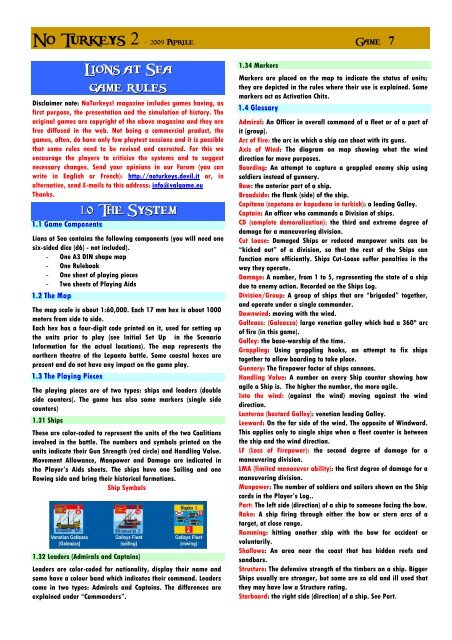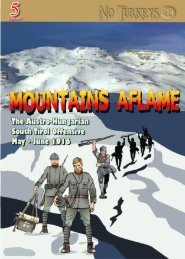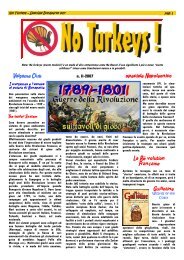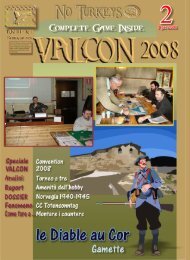Create successful ePaper yourself
Turn your PDF publications into a flip-book with our unique Google optimized e-Paper software.
<strong>No</strong> <strong>Turkeys</strong> 2 – <strong>2009</strong> Aprile Game 7<br />
Lions at Sea<br />
game rules<br />
Disclaimer note: <strong>No</strong><strong>Turkeys</strong>! magazine includes games having, as<br />
first purpose, the presentation and the simulation of history. The<br />
original games are copyright of the above magazine and they are<br />
free diffused in the web. <strong>No</strong>t being a commercial product, the<br />
games, often, do have only few playtest sessions and it is possible<br />
that some rules need to be revised and corrected. For this we<br />
encourage the players to criticize the systems and to suggest<br />
necessary changes. Send your opinions in our Forum (you can<br />
write in English or French): http://noturkeys.devil.it or, in<br />
alternative, send E-mails to this address: info@valgame.eu<br />
Thanks.<br />
11. ..11 GGaammee CCoommppoonneennt tss<br />
1.0 The System<br />
Lions at Sea contains the following components (you will need one<br />
six-sided dice (d6) - not included).<br />
- One A3 DIN shape map<br />
- One Rulebook<br />
- One sheet of playing pieces<br />
- Two sheets of Playing Aids<br />
11. ..22 TThhee Maapp<br />
The map scale is about 1:60,000. Each 17 mm hex is about 1000<br />
meters from side to side.<br />
Each hex has a four-digit code printed on it, used for setting up<br />
the units prior to play (see Initial Set Up in the Scenario<br />
Information for the actual locations). The map represents the<br />
northern theatre of the Lepanto battle. Some coastal hexes are<br />
present and do not have any impact on the game play.<br />
11. ..33 TThhee PPl llaayyi iinngg PPi iieec ceess<br />
The playing pieces are of two types: ships and leaders (double<br />
side counters). The game has also some markers (single side<br />
counters)<br />
1.31 Ships<br />
These are color-coded to represent the units of the two Coalitions<br />
involved in the battle. The numbers and symbols printed on the<br />
units indicate their Gun Strength (red circle) and Handling Value.<br />
Movement Allowance, Manpower and Damage are indicated in<br />
the Player’s Aids sheets. The ships have one Sailing and one<br />
Rowing side and bring their historical formations.<br />
Ship Symbols<br />
1.32 Leaders (Admirals and Captains)<br />
Leaders are color-coded for nationality, display their name and<br />
some have a colour band which indicates their command. Leaders<br />
come in two types: Admirals and Captains. The differences are<br />
explained under “Commanders”.<br />
1.34 Markers<br />
Markers are placed on the map to indicate the status of units;<br />
they are depicted in the rules where their use is explained. Some<br />
markers act as Activation Chits.<br />
11. ..44 GGl lloossssaar ryy<br />
Admiral: An Officer in overall command of a fleet or of a part of<br />
it (group).<br />
Arc of Fire: the arc in which a ship can shoot with its guns.<br />
Axis of Wind: The diagram on map showing what the wind<br />
direction for move purposes.<br />
Boarding: An attempt to capture a grappled enemy ship using<br />
soldiers instead of gunnery.<br />
Bow: the anterior part of a ship.<br />
Broadside: the flank (side) of the ship.<br />
Capitana (capetana or kapudana in turkish): a leading Galley.<br />
Captain: An officer who commands a Division of ships.<br />
CD (complete demoralization): the third and extreme degree of<br />
damage for a maneuvering division.<br />
Cut Loose: Damaged Ships or reduced manpower units can be<br />
“kicked out” of a division, so that the rest of the Ships can<br />
function more efficiently. Ships Cut-Loose suffer penalties in the<br />
way they operate.<br />
Damage: A number, from 1 to 5, representing the state of a ship<br />
due to enemy action. Recorded on the Ships Log.<br />
Division/Group: A group of ships that are “brigaded” together,<br />
and operate under a single commander.<br />
Downwind: moving with the wind.<br />
Galleass: (Galeazza) large venetian galley which had a 360° arc<br />
of fire (in this game).<br />
Galley: the base-warship of the time.<br />
Grappling: Using grappling hooks, an attempt to fix ships<br />
together to allow boarding to take place.<br />
Gunnery: The firepower factor of ships cannons.<br />
Handling Value: A number on every Ship counter showing how<br />
agile a Ship is. The higher the number, the more agile.<br />
Into the wind: (against the wind) moving against the wind<br />
direction.<br />
Lanterna (bastard Galley): venetian leading Galley.<br />
Leeward: On the far side of the wind. The opposite of Windward.<br />
This applies only to single ships when a fleet counter is between<br />
the ship and the wind direction.<br />
LF (Loss of Firepower): the second degree of damage for a<br />
maneuvering division.<br />
LMA (limited manoeuver ability): the first degree of damage for a<br />
maneuvering division.<br />
Manpower: The number of soldiers and sailors shown on the Ship<br />
cards in the Player’s Log..<br />
Port: The left side (direction) of a ship to someone facing the bow.<br />
Rake: A ship firing through either the bow or stern arcs of a<br />
target, at close range.<br />
Ramming: hitting another ship with the bow for accident or<br />
voluntarily.<br />
Shallows: An area near the coast that has hidden reefs and<br />
sandbars.<br />
Structure: The defensive strength of the timbers on a ship. Bigger<br />
Ships usually are stronger, but some are so old and ill used that<br />
they may have low a Structure rating.<br />
Starboard: the right side (direction) of a ship. See Port.






